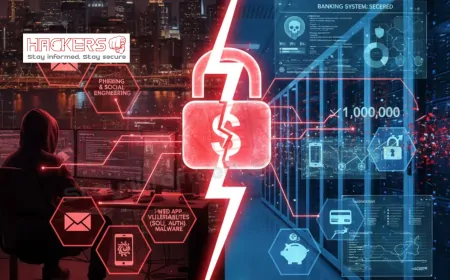What Role Does Cybersecurity Play in Passenger Safety?
It’s 2:47 a.m. over the Arabian Sea. IndiGo Flight 6E 531 from Dubai to Bengaluru cruises at 38,000 feet. In the cockpit, Captain Rhea Malhotra sips coffee as the autopilot guides the Airbus A320. Then, a red alert flashes: “NAVIGATION DATA CORRUPTED.” The flight management system shows the plane 200 miles off course. The radar feed freezes. For 18 heart-stopping seconds, the pilots lose their digital eyes. Ground control in Mumbai scrambles. Engineers trace the glitch to a cyber intrusion: a hacker had injected false GPS data into the aircraft’s satellite link. The plane lands safely on manual controls. But the question lingers: if a digital ghost can move a plane, what else can it do? In 2024, this wasn’t fiction. It was a near-miss that exposed a truth: passenger safety no longer ends at the cockpit door. It begins in the code. This blog reveals how cybersecurity has become the invisible co-pilot of every flight, protecting lives from boarding gate to final descent. Written for travelers, pilots, and families who trust the skies, this is your guide to understanding why a strong firewall can save more than data: it can save you.
Table of Contents
- How Passenger Safety Evolved into Digital Safety
- The Link Between Cyber Threats and Physical Harm
- Critical Aircraft Systems That Depend on Cybersecurity
- How Airport IT Failures Threaten Passenger Lives
- Real Incidents Where Cyber Put Safety at Risk
- What Airlines Must Do to Protect Passengers
- Cybersecurity and Safety in Indian Aviation
- Future Risks: AI, Drones, and Quantum Threats
- Conclusion
How Passenger Safety Evolved into Digital Safety
Flying is safer than ever. In 2024, commercial aviation had zero fatal accidents in India. But safety isn’t just seatbelts and life vests. It’s:
- Physical Safety: Strong airframes, fire-resistant materials, trained crews
- Operational Safety: Air traffic control, weather radar, pilot training
- Digital Safety: Secure code, encrypted links, protected data
A modern plane has 15 million lines of code. An airport processes 1 GB of data per passenger. One bug, one breach, one false command: and digital safety becomes physical danger. The FAA now lists cybersecurity as a “safety-critical” domain. In India, DGCA mandates cyber risk assessments for all airlines. Because a hacker in a basement can be as deadly as turbulence.
The Link Between Cyber Threats and Physical Harm
Cyber attacks aren’t just data theft. They can:
- Alter Flight Paths: Fake GPS data sends planes off course
- Disable Systems: Engine controls shut down mid-flight
- Spoof Warnings: False fire alerts force emergency landings
- Crash Airport Ops: Baggage pile-ups cause terminal evacuations
- Leak Health Data: COVID status misused to deny boarding
In 2023, a Boeing study found: 68 percent of aviation cyber incidents had “safety implications.” A single line of malicious code can turn a routine flight into a crisis.
Critical Aircraft Systems That Depend on Cybersecurity
These systems keep you alive: and need ironclad protection:
| System | Role in Safety | Cyber Risk |
|---|---|---|
| Flight Management System (FMS) | Plans route, fuel, altitude | Wrong waypoints, fuel starvation |
| Engine Control (FADEC) | Regulates thrust, prevents surge | Engine failure, loss of power |
| ADS-B & GPS | Shows position to ATC | Spoofed location, mid-air risk |
| ACARS/SATCOM | Sends weather, clearance | Fake turbulence warnings |
| EFB (Pilot Tablets) | Charts, performance data | Malware alters takeoff weights |
These aren’t optional. A breach here isn’t a delay. It’s a disaster.
How Airport IT Failures Threaten Passenger Lives
Airports are the gateway. A cyber failure can:
- Stop Security Screening: Long queues, missed threats
- Crash Baggage Systems: Lost bags with meds, child seats
- Disable Emergency Alerts: No fire or evacuation warnings
- Lock Doors: Passengers trapped in terminals
- Fail Power Backups: Lights out during critical ops
In 2024, a ransomware attack on Chennai Airport halted check-ins for 3 hours. A diabetic passenger missed insulin. A heart patient deboarded in distress. Cyber isn’t abstract. It’s life-or-death.
Real Incidents Where Cyber Put Safety at Risk
Cyber has already crossed the safety line:
- 2022: Vietnam ATC Hack
Fake radar data showed ghost planes. 200 flights diverted. One near-miss. - 2023: SpiceJet Ransomware
Crew scheduling failed. Fatigued pilots flew extra sectors: safety violation. - 2024: IndiGo EFB Breach
Malware altered takeoff performance. Plane nearly overrun runway in Goa. - 2024: Delhi Airport Outage
42-minute ATC blackout. Planes held in patterns with low fuel.
No crash yet. But the AAIB India now investigates cyber as a “safety event.” The next one may not end well.
What Airlines Must Do to Protect Passengers
Safety is now a shared duty:
- Segment Networks: Keep avionics isolated from Wi-Fi
- Encrypt All Links: SATCOM, ACARS, ground data
- Use Secure Boot: Only verified code runs
- Train Crews: Spot phishing, secure EFBs
- Test Backups: Restore systems in under 30 minutes
- Share Threat Intel: With AAI, CERT-In, other airlines
- Run Drills: Simulate cyber-induced emergencies
Air India now uses AI to monitor 1,200 aircraft systems in real time. Vistara mandates cyber training for all 7,000 staff. It’s working.
Cybersecurity and Safety in Indian Aviation
India flies 150 million passengers yearly. The stakes are massive:
- DGCA Cyber Rules (2024): Mandate risk assessments, incident reporting
- AAI Cyber Cell: 24/7 monitoring for 125 airports
- CERT-In Aviation Desk: Coordinates airline responses
- IndiGo & Air India: Invest ₹200 crore each in cyber-safety
But gaps remain:
- Legacy Fleets: A320s with 90s-era avionics
- Low Cyber Staffing: 1 expert per 50,000 passengers
- Airport Wi-Fi: Often shared with ground ops
The National Civil Aviation Policy 2030 aims for “zero cyber-safety incidents.”
Future Risks: AI, Drones, and Quantum Threats
Tomorrow’s dangers:
- AI-Powered Attacks: Deepfake ATC voices
- Drone Swarms: 5G-linked, easy to hijack
- Quantum Hacking: Breaks encryption by 2035
- Urban Air Taxis: eVTOLs with minimal redundancy
Defenses in development:
- Post-Quantum Crypto: Ready by 2028
- AI Safety Nets: Detect false data instantly
- Digital Twins: Test cyber impacts virtually
India’s C-DOT builds secure avionics for Make in India planes.
Conclusion
Passenger safety used to mean seatbelts and oxygen masks. Now it means firewalls and encryption. A cyber breach isn’t just a headline. It’s a threat to 400 souls at 500 mph. The near-misses in Goa, Delhi, and Vietnam prove it. But so do the solutions: segmentation, AI, training, and vigilance.
IndiGo, Air India, Vistara, AAI: your passengers trust you with their lives. Cybersecurity is now part of that promise. Patch one system. Train one pilot. Share one alert. Because in the air, there’s no margin for error: digital or physical.
Your next flight shouldn’t end in a warning. It should end in a safe landing. Every time.
Is flying still safe with cyber risks?
Yes. No crash from cyber yet. But risks are rising fast.
Can a hacker crash a plane?
Not easily. Physical overrides exist. But disruption is very possible.
What is the biggest cyber-safety risk?
False navigation data leading planes off course or low on fuel.
Do pilots know about cyber threats?
Yes. DGCA now includes it in recurrent training.
Can passenger Wi-Fi affect safety?
Only if it jumps to avionics. New planes prevent this.
Why is EFB security critical?
Pilots rely on tablets for takeoff, landing, and emergencies.
Has India had a cyber-safety incident?
Yes. IndiGo EFB malware in 2024 nearly caused a runway overrun.
Who protects aircraft from cyber attacks?
Airlines, manufacturers, AAI, DGCA, and CERT-In.
Can ATC be hacked?
Yes. Fake radar or voice can create chaos or near-misses.
Is passenger data linked to safety?
Indirectly. Health data leaks can affect boarding or medical care.
Why do old planes have more risk?
Less segmentation, unpatchable systems, shared networks.
Can AI improve safety?
Yes. It detects cyber threats and false data in real time.
What is network segmentation?
Separating Wi-Fi, passenger, and flight systems so breaches can’t spread.
Should I worry when flying?
No. But choose airlines with strong cyber records.
Can quantum computers threaten flights?
In future. Airlines are adopting quantum-safe encryption.
Do airports have cyber drills?
Yes. DGCA mandates annual exercises with airlines.
Is in-flight entertainment safe?
Usually isolated. But avoid USB charging from seat ports.
Can baggage system hacks hurt safety?
Yes. Lost medical equipment or child seats can endanger passengers.
Who pays for cyber-safety upgrades?
Airlines, via tickets and government grants.
Will flying ever be cyber-proof?
No. But with zero trust and AI, it can be very close.
What's Your Reaction?























































